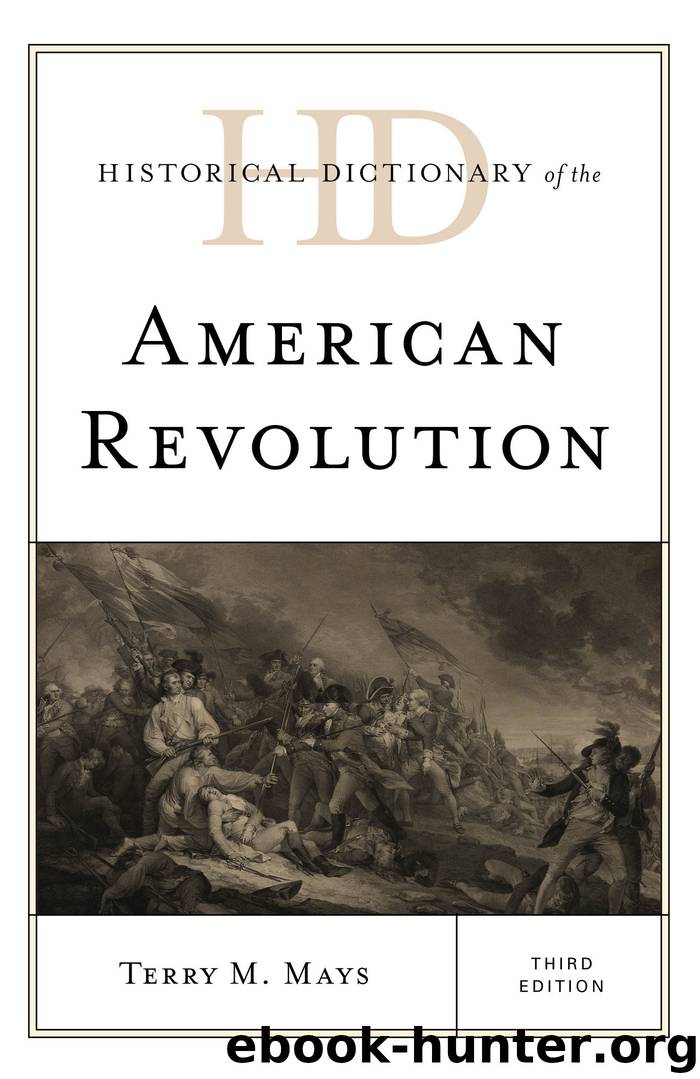Historical Dictionary of the American Revolution by Terry M. Mays

Author:Terry M. Mays
Language: eng
Format: epub
Tags: undefined
Publisher: Rowman & Littlefield Publishers
Published: 2012-01-01T16:00:00+00:00
REGULATION, WAR OF THE
See REGULATORS.
REGULATIONS FOR THE ORDER AND DISCIPLINE OF THE TROOPS OF THE UNITED STATES
The title of the drill book written for the Continental Army by General Friedrich von Steuben while at Valley Forge. This book remained the standard drill manual of the American army until 1812.
REGULATORS
This term is applied to the frontiersmen whose opposition to the royal government in North Carolina beginning in 1764 culminated in the Battle of the Alamance in 1771. This period has been referred to as the War of the Regulation by some scholars. The Regulators viewed the appointed governors of North Carolina as tyrannical. However, the basic grievance of the Regulators dealt with excessive taxes and the dishonesty of local sheriffs. The latter individuals often embezzled as much as and sometimes more than half of the taxes they were appointed to collect. Governor William Tryon of North Carolina admitted that the problem existed but found it difficult to correct. The frontiersmen felt isolated by the easterners but lacked a leader to organize them. Herman Husband rose as an organizer of the movement but broke ranks when the Regulators turned to armed revolt. The Regulators initiated riots and other acts of violence during the collection of taxes in 1765.
The group was called “the mob” beginning in 1768 following the opposition to the new Orange County tax collection system and the announcement that Governor Tryon planned to build a new residence at public expense. “The mob” was later changed to “the regulation,” from which we now derive the name Regulators. The goals of the frontiersmen included holding a conference for the regulation of public grievances.
Between 1768 and 1771, the Regulators continued to oppose their local governments with increasing tenacity. In 1769, Governor Tryon led a force of militia to Hillsboro in response to a plea by the superior court justices in the town. The justices claimed that they were not able to conduct business due to the Regulators and feared for their lives. Tryon’s force of 1,500 militiamen confronted a group of 3,700 Regulators and persuaded them to disband. However, this show of force did nothing to alleviate the grievances of the frontiersmen.
In March 1771, following continued Regulator violence, Governor Tryon and General Hugh Waddell led two militia groups into the western frontier. The resulting Battle of the Alamance left Governor Tryon in control of the area and effectively ended the resistance.
After the battle, most of the Regulators and their supporters swore an oath of allegiance to the government, but many others moved to Tennessee and Kentucky to avoid the process. Newspaper coverage of the Regulators’ struggles helped stir others in their opposition to Great Britain. Five years later, North Carolinians would again clash at the Battle of Moore’s Creek Bridge.
The Regulator movement is a controversial topic in Revolutionary War history. Many scholars view the Regulators and their movement as a prelude to the American Revolution similar to revolts in the northern colonies such as the Boston Tea Party. These scholars tend to see the Battle of the Alamance as the first shooting engagement of the American Revolution.
Download
This site does not store any files on its server. We only index and link to content provided by other sites. Please contact the content providers to delete copyright contents if any and email us, we'll remove relevant links or contents immediately.
| Dictionaries | English |
| Foreign Language Dictionaries & Thesauruses | Lexicography |
| Slang & Idioms | Synonyms & Antonyms |
| Thesauruses |
A Dictionary of Sociology by Unknown(3044)
The Art of Dramatic Writing: Its Basis in the Creative Interpretation of Human Motives by Egri Lajos(3037)
The Dictionary of Body Language by Joe Navarro(2969)
0041152001443424520 .pdf by Unknown(2815)
How The Mind Works by Steven Pinker(2777)
Day by Elie Wiesel(2746)
Merriam-Webster's Collegiate Thesaurus, Second Edition by Merriam-Webster Inc(2731)
The Meaning of the Library by unknow(2534)
The Official Guide to the TOEFL Test by ETS(2301)
A History of Warfare by John Keegan(2214)
The Emotion Thesaurus: A Writer's Guide to Character Expression by Puglisi Becca & Ackerman Angela(2127)
Emotion Amplifiers by Angela Ackerman & Becca Puglisi(2016)
MASTER LISTS FOR WRITERS: Thesauruses, Plots, Character Traits, Names, and More by Bryn Donovan(1923)
Merriam-Webster's Pocket Dictionary by Merriam-Webster(1910)
The Cambridge Guide to English Usage by PAM PETERS(1890)
Star Wars The Rise of Skywalker The Visual Dictionary by Pablo Hidalgo(1865)
More Than Words (Sweet Lady Kisses) by Helen West(1837)
Lucky Jim by Kingsley Amis(1729)
American Accent Training by Ann Cook(1643)
